(Reproduction of
this text is authorized provided the holder is preserved and mentioned
- Copyright : Marcus Martins - PY4SM / PY2DD)
(Reproduction of
this text is authorized provided the holder is preserved and mentioned
- Copyright : Marcus Martins - PY4SM / PY2DD)
|
The telegraph, as says our colleague José Geraldo Padua- PY2JGP, "is the art of transmitting coded messages through a specific device called the telegraph." The different sounds produced to manipulate the telegraph are able to offer a perfect understanding to the human ear. The system is represented by international convention signals and composed of larger signals ( traces ) or smaller ( points) on each letter and the pace is what will differentiate between them. As the signals form the sound, each letter has its distinctive sound, making it unmistakable with another letter or number, because the sound differs, so we briefly telegraphy, as a sound language and rhythm, making it a coded language. |
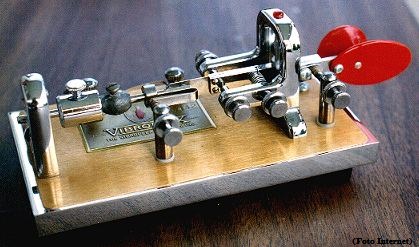
![]() We can define as wired telegraphy, the message transmission in Morse code
signals with the help of current flowing through the electrical circuit that
connects the transmitter to the receiver equipment. The wireless telegraphy is
the same transmission in Morse Code and that the signals are carried by
electromagnetic waves through space.
We can define as wired telegraphy, the message transmission in Morse code
signals with the help of current flowing through the electrical circuit that
connects the transmitter to the receiver equipment. The wireless telegraphy is
the same transmission in Morse Code and that the signals are carried by
electromagnetic waves through space.
A dentist named Mahlon Loomis received US Patent
129,971 for a "supposed" wireless telegraphy in 1872. This patent, a
single-page, is a very vague statement about the use of "air power" to
eliminate the overhead wire used by systems existing telegraph, but does not
contain any scheme or diagram of how to build it, nor any theory of how it
might work. Loomis imagined towers "at the top of the high mountains, and so
establish the electrical connection with the strata of the atmosphere for
forming the electric circuit." Loomis patent is substantially similar to US
Patent 126.356 that was received three months prior to Ward by William Henry
It requested it on June 29, 1871, when Loomis was actively promoting the idea
of using atmospheric electricity to the telegraph. Ward patent also does not
contain any schematic. Instead, Ward illustrates and describes towers turning
against the wind "to drive an air current power supply within the isolated
portion of the tower where the current is passed upwardly through the top of
the tower and out through the ventilator or top. It states that the tower
continually receive new electricity supplies. "
The two patents, in a few paragraphs, use almost identical language :
Both never proved these inventions.
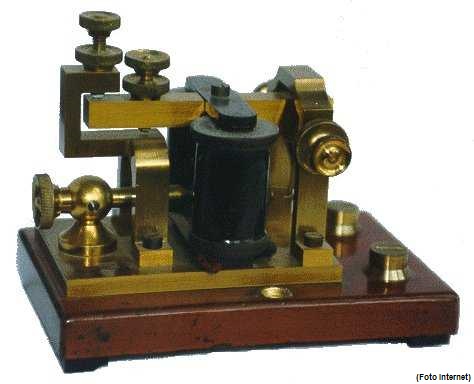
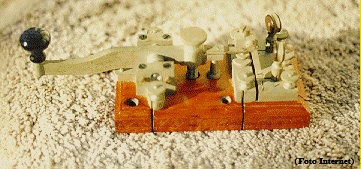 |
The telegraph was invented by the American Samuel Finley Breese Morse,
who in addition to inventing the telegraph, guided and prepared the
relevant code, which also bore his name. The Morse code until now
known, used and spread around the world, are short signals ( points)
and long (dashes ) combined to match the numbers and letters of the
alphabet, thus producing different sounds, each letter, number or
punctuation has its characteristic sound, making it unmistakable. |
|
But the wireless telegraph was definitely invented by Italian engineer
Gugliemo Marconi, who in the year 1895 began the transmission and
reception of signals via electromagnetic waves, wireless, using the
telegraph by Samuel Morse. Marconi consolidated several discoveries of
the time, achieving total success in transmitting and receiving Morse
code signals by radio over wireless telegraphy, and shall be accorded
the device patent in the year 1896 in England |
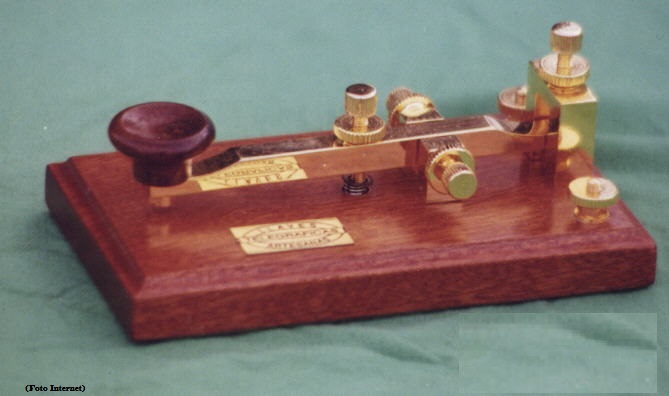 |
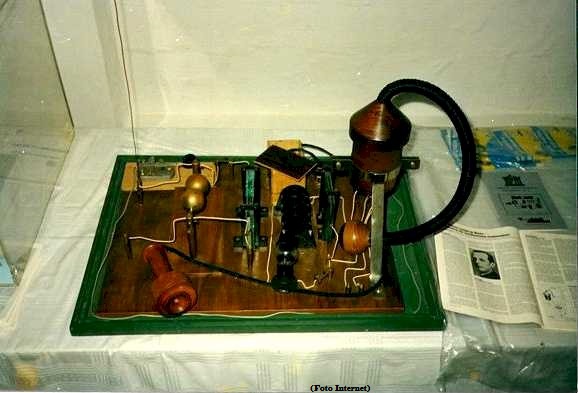 |
The radio and
amateur radio emerged almost
simultaneously because of the great interest in researching all
electromagnetic phenomena. Despite the dizzying technological
development of today, artisanal assembly equipment gained a
connotation of substantial challenge that remains in the practices of
amateurs as well as the extensive research field around antennas,
propagation of radio electric signals carried by electromagnetic waves
and Technological Research. |
|
The telegraph was invented by Samuel Finley Breese Morse, born April 27, 1791 in Charlestown, Massachusetts - United States, he studied at Yale College, where he became interested in electricity. In 1832, during a boat trip, he participated in a debate on the electromagnet, still little known device. In 1835 it built its first functional prototype telegraph whose research and developments extended until mid-year 1838 when, finally, was a really functional signs of code called Morse code. In 1843 he managed funds for his invention through the US Congress, and in 1844 was completed the first telegraph line linking Baltimore to Washington, DC. In his first official broadcast the message was: "What hath God wrought !
Samuel Morse died on April 2, 1872, in New York.
The telegraph is still widely used by global communications. Since the
Second World War came to be used in parallel with other modes of
transmission such as
SSB Single
Side Band, currently uses up the radio package for encrypted
communications but Morse code is still being used in various
applications of terrestrial communications and air and maritime
navigation. Also some satellites use the Morse code for its
identification signal location and telemetry . The Morse code is also (largely ) used worldwide by ham radio, where every day, thousands of " dots and dashes " cross the air through the broadcasts of this enthusiastic communications. On the internet we can find Morse code training software.
The telegraph was inaugurated in Brazil in 1857, with the installation of the first telegraph line between the beach of Health in the city of Rio de Janeiro and the city of Petrópolis. This first line had a length of 50 km, with 15 km of submarine cable in the bed of Guanabara Bay. The first international connection by submarine cable was due to the initiative of Irineu Evangelista de Souza, who by Decree No. 5058 of August 16, 1872, got the privilege for 20 years to lay submarine cables and explore electric telegraphy between Brazil and Europe.
On December 23, 1873 was made a connection between the cities of Rio
de Janeiro and of
Belem,
Recife and
Salvador,
in the presence of Emperor
Dom Pedro
II, who watched the arrival of submarine cable to Brazil, and
completion of the link in a building erected for this purpose at the
end of
Copacabana beach. Once the connection has been established, the
Emperor sent cables to the presidents of those three provinces, as
follows:
"I think if the
submarine cable in the territory of Brazil's capital. Electricity
begins to connect the most important cities of this empire, like
patriotism meets all Brazilians the same commitment to the prosperity
of our majestic country. The Emperor therefore welcomes the the
states of Bahia, Pernambuco and Pará, for as fausto event, as their
first compatriot and sincere friend. Even the good year
1874.
That same day, for services to the Empire of Brazil, the then Baron of
Mauá was elevated to Visconde de Mauá.
On June 22, 1874, it was completed the connection with Europe, between
the stations of Recife and Carcavelos (in Portugal ), via Cape Verde
and Madeira. The news was received by the Emperor when visiting the
National Library, then installed in the street Ride No. 46. This move
sent cables to the president of the Brazilian Submarine Telegraph
Company (later Western Telegraph Co. Ltd.) and the monarchs of
Portugal, England and Austria. At the time there were demonstrations
at City Hall and popular jubilation, and the press reported, for
several days, news about it.
The following year (1875), the connection between Recife, João Pessoa and Natal was established. Later, in 1893 the English company South American Cables Ltd. installed a submarine cable in Fernando de Noronha. In 1914 the granting of this cable was transferred to France. A second submarine cable on the same island was launched by the Italian Italcable in 1925.
|
|
Since the dawn of civilization, because the need for communication at
distance, man created numerous systems that would enable the
transmission of your messages. This transmission originally performed
by means of sound or light signals in place and being translated in
other common code. Among the telegraph systems the world's leading
listed the Samuel Morse (USA), Wheatstone (England) and the Steinhail
(Germany). The Morse system was the one that presented more fully,
keeping its basic lines to this day. In very recent times it was
created the Advisory Committee Inter -national Telegraph, in order to
standardize telegraph transmissions, adopting standardized coding and
frequencies.
In November 1997 there was the World Radio Conference ( CRM -97 ) ITU ( International Telecommunication Union ), which is the international body responsible for standardizing all telecommunications on our planet. This Conference was presented and approved the official pronouncement ITU / IARU regarding the use of telegraphy in the world. Nothing affected the amateur radio service, and decisions about possible changes in the requirements of the tests MORSE CODE, were postponed to a later date.
References to the
immediate termination of the CW, is the result of misinformation and confusion. It turns out that the
services using the Morse code by Marine from various countries
has been closed, and that, fortunately HAS no relation to the amateur
radio service. |
Moreover, questions about a possible realignment of the range of 40
meters, seeking to resolve a conflict between the amateur service and the
broadcasting service, subject considered very important in the amateur, is
practically solved only missing some details with the Soviet Union and
China.
LETTERS
SIGNS MORSE CODE
A
. -
B
- . . .
C
- . - .
D
- . .
E
.
É
. . - . .
F
. . - .
G
- - .
H
. . . .
I
. .
J
. - - -
K
- . -
L
. - . .
M
- -
N
- .
O
- - -
P
. - - .
Q
- - . -
R
. - .
S
. . .
T
-
U
. . -
V
. . . -
W
. - -
X
- . . -
Y
- . - -
Z
- - . .
NUMBERS
SIGNS MORSE CODE
1
2
3
4
5
6
7
8
9
0
D E S C R I P T I O N
REPRESENTATION
SIGNS MORSE CODE
( . )
. - . - . -
( , )
- - . . - -
( : )
- - - . . .
Question mark (question note or interpellation to repeat a missed
transmission)
( ? )
. . - - . .
( ' )
. - - - - .
Hyphen or dash or minus sign
( - )
- . . . . -
Fraction bar or division sign
( / )
- . . - .
( ( )
- . - - .
( ) )
- . - - . -
Quotation (acceptance marks) before and after the words
( " )
. - . . - . Double
hyphen
( = )
- . . . -
n/c
. . . - .
. . . . . . . .
( + )
. - . - .
- . -
. - . . .
. . . - . -
Start signal (start ) ( to precede every transmission)
- . - . -
Multiplication sign
( x )
_ . . _
. - - - -
. . - - -
. . . - -
. . . . -
. . . . .
- . . . .
- - . . .
- - - . .
- - - - .
- - - - -
Full stop
Comma
Two points or division
sign
Apostrophe
Left Parenthesis
Right
Parenthesis
Understood
Error (eight points)
n/c
Cross or Plus sign
Call for transmission
n/c
Waiting
n/c
Awaiting final
n/c
n/c
International Code "Q"
|
QRA - Operator name ,
or station.
QRB - What to its
distance ?
QRD - What is your
location ?
QRG - Operating
Frequency
QRH - Their frequency
varies
QRI - Tone signals ( 1
to 5 )
QRK - Readability of
signs ( 1 to 5 )
QRL - I'm busy . Do not
interfere please
QRM - interference from
another station
QRN - Atmospheric
interference or static
QRO - Increase your
power
QRP - Decrease your
power
QRQ - faster Handle
QRR - S.O.S. land
QRS - Handle slower
QRT - I'll stop has
assigned
QRU - Do you have
anything for me
QRV - I'll be at your
disposal
QRW - Station "X" flame
... K
QRX -
Wait your turn to pass
QRY - When is my turn to pass
QRZ - Who is calling me ?
QSA - intensity signals ( 1 to 5 )
QSB - Your signal varies
DSF - Its transmission is defective
QSJ - rate - Money - Value |
QSN - Do you hear me ?
QSO - Notice or contact
QSP - Message Relay to
another station
QST - Notice of general
interest
QSU - Transmit or
listen on ... kHz
QSL - Send a series of
" V "
QSW - I will pass on
this or another frequency ?
QSX - will hear your
message in ... KHZ
QSY - I will transmit
on another frequency ! Shall we?
QSZ - Shall I send each
word or group?
QTA - set aside the
previous message
QTB - I agree w / your
word count
QTC - Message - News
QTH - Place where it
will station
QTR - Hours - Time
QTX - I'll be out
indefinitely
QUZ - I got your
Emergency signal
QUF - I got your
distress signal
QAP - Standing always
listening
CQ - General call
DX - Contact to
distance
AS - Waiting OK
- all right - Understood TV
- TV 51
- Handshake 55
- Happiness 73
- My compliments - Hugs |
INTERESTING LINKS